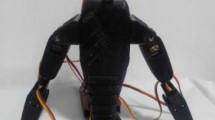Abstract
In this paper, error modeling and analysis of a typical 3-degree of freedom translational Parallel Kinematic Machine is presented. This mechanism provides translational motion along the Cartesian X-, Y- and Z-axes. It consists of three limbs each having an arm and forearm with prismatic-revolute-revolute-revolute joints. The moving or tool platform maintains same orientation in the entire workspace due to its joint arrangement. From inverse kinematics, the joint angles for a given position of tool platform necessary for the error modeling and analysis are obtained. Error modeling is done based on the differentiation of the inverse kinematic equations. Variation of pose errors along X, Y and Z directions for a set of dimensions of the parallel kinematic machine is presented. A non-dimensional performance index, namely, global error transformation index is used to study the influence of dimensions and its corresponding global maximum pose error is reported. An attempt is made to find the optimal dimensions of the Parallel Kinematic Machine using Genetic Algorithms in MATLAB. The methodology presented and the results obtained are useful for predicting the performance capability of the Parallel Kinematic Machine under study.
Similar content being viewed by others
References
Stewart D. A platform with six degrees of freedom. In: Proc Auto Inst. Mech. Engg, London, 1965, 180(5): 371–386
Koteswara Rao A B, et al. Dimensional design of hexaslides for optimal workspace and dexterity. IEEE Transactions on Robotics-IEEE-TRO, 2005, 21(3): 444–449
Merlet J P. Parallel Robots. The Netherlands: Kluwer Academic Publishers, 2000
Clavel R. Delta: a fast robot with parallel geometry. 18th International Symposium on Industrial Robots. Sydney, Australia, 1988: 91–100
Pierrot F, Reynaud C, Fournier A. DELTA: a simple and efficient parallel robot. Robotica, 1990, 8(02): 105–109
Haung T, Whitehouse D J, Wang J. The local dexterity, optimal architecture and design criteria of parallel machine tools. Annals of the CIRP, 1998, 1988(47): 347–351
Tsai L W. Kinematics of a three-DOF platform manipulator with three extensible limbs. In: Lenarcic J, Parenti-Castelli V, eds. Advances in Robot Kinematics Kluwer Academic Publishers, 1996, 401–410
Li Y, Xu Q, Li Y M, Xu Q S. Kinematic analysis and design of a new 3-DOF Translational Parallel Manipulator. Journal of Mechanical Design, 2006, 128(4): 729–738
Kim H S, Tsai L W. Design optimization of a Cartesian parallel manipulator. Journal of Mechanical Design, 2003, 125(1): 43–51
Niaritsiry T F, et al. Study of the Sources of Inaccuracy of a 3-DOF Flexure Hinge-Based Parallel Manipulator. Proceedings of IEEE International conference on Robotics and Automation New Orieans, LA. April 2004
Wang J, Masory O. on the accuracy of a Stewart platform — Part 1: The effect of manufacturing tolerances. In: IEEE Int. Conf. on Robotics and Automation, Atlanta, GA, USA, 1993, 114–120
Masory O, Wang J. On the accuracy of a Stewart platform — Part 2: Kinematic calibration and compensation. In: IEEE Int. Conf. on Robotics and Automation, Atlanta, GA, USA, 1993, 725–731
Patel A J, Ehmann K F. Volumetric error analysis of a Stewart platform-based machine tool. CIRP Annals, 1997, 46(1): 287–290
Zhuang H Q, Liu L X. Self-calibration of a class of Parallel Manipulators. Proceedings IEEE International conference on Robotics and Automation, 1996, 0-7803-2988-4
Ryu J, Cha J. Volumetric error analysis and architecture optimization for accuracy of Hexaslide type parallel manipulators. Mechanism and Machine Theory, 2003, 38(1): 227–240
XU Q S, Li Y M. Error analysis and optimal design of a class of translational parallel kinematic machine using particle swarm optimization. Robotica, 2003, 27(1): 227–240
Zhao J W, et al. Error analysis of a serial-parallel type machine tool. International Journal of Advanced Manufacturing Technology, 2002, 19: 174–179
Verner M, Xi F, Mechefske C. Optimal calibration of Parallel Kinematic Machines. Journal of Mechanical Design, 2005, 127(1): 62–69
Tian H, et al. Error modeling, sensitivity analysis and assembly process of a class of 3-DOF Parallel Kinematic Machines with parallelogram struts. Science in China (series E), 2002, 45(5): 467–476
Caro S, Wenger P, Bennis F, Chablat D. Sensitivity analysis of the orthoglide. A 3-DOF translational parallel kinematic machine. ASME Journal of Mechanical Design, 2006, 128(2): 392–402
Yu A, Bonev I A, Zsombor-Murray P. Geometric method for the accuracy analysis of a class of 3-DOF Planar Parallel Robots. Mechanism and Machine Theory, 2008, 43(3): 364–375
Nicolas B, et al. Comparision of 3-RPR Planar Parallel Manipulators with regard to their kinetostatic performance and sensitivity to geometric uncertainities. Mechanica, 2011, 46(1): 75–88
Daxing Zeng et al., Performance analysis and optimal design of a 3-DOF 3-PRUR parallel mechanism. Journal of Mechanical Design, 2008, 130: 042307 (1–11)
Oscar Altuzarra et al. Optimal dimensioning for parallel manipulators: workspace, dexterity, and energy. Journal of Mechanical Design, 2011, 133: 041007(1–5)
Liu X J, Wang J, 0. Jinsong Wang. A new methodology for optimal kinematic design of parallel Mechanisms. Mechanism and Machine Theory, 2007, 42(9): 1210–1224
Bi Z M, Lang S Y T, Zhang D, Orban P E, Verner M. Integrated design toolbox for tripod-based parallel kinematic machines. Journal of Mechanical Design, 2007, 129(8): 799–806
Author information
Authors and Affiliations
Corresponding author
Rights and permissions
About this article
Cite this article
Shankar Ganesh, S., Koteswara Rao, A.B. Error analysis and optimization of a 3-degree of freedom translational Parallel Kinematic Machine. Front. Mech. Eng. 9, 120–129 (2014). https://doi.org/10.1007/s11465-014-0300-3
Received:
Accepted:
Published:
Issue Date:
DOI: https://doi.org/10.1007/s11465-014-0300-3




